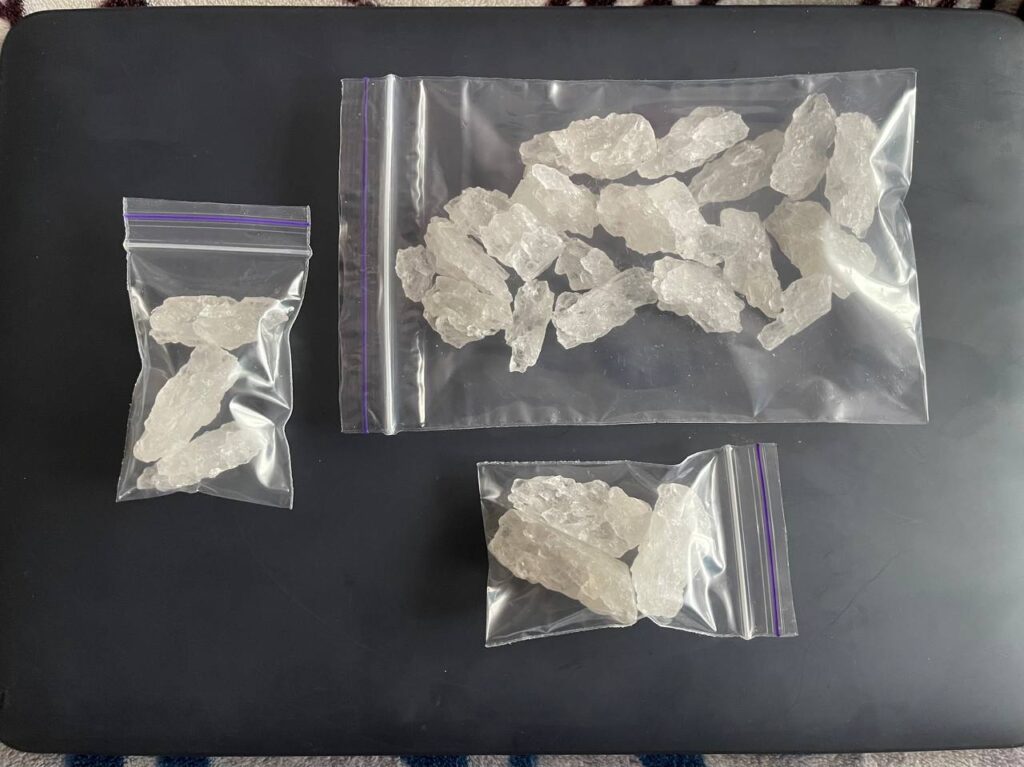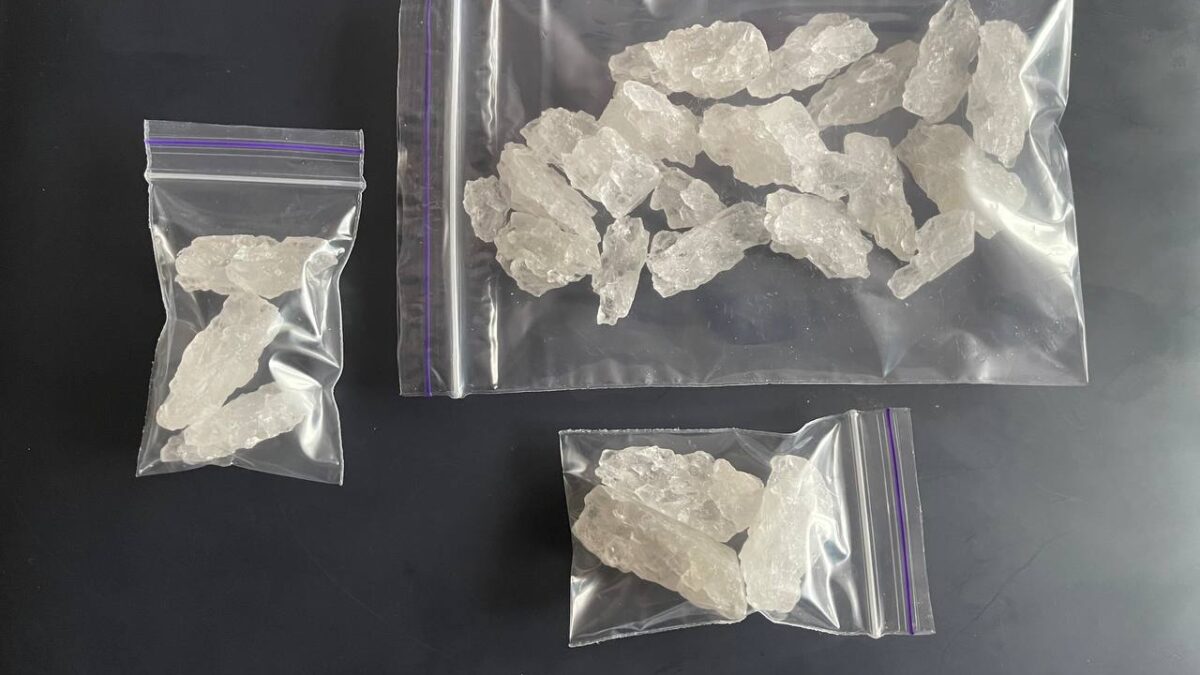Methamphetamine

Methamphetamine and Ice Drug Information

KNOW THE DIFFERENCE BETWEEN ICE AND METH (AND WHY IT MATTERS)
Methamphetamine (contracted from N–methylamphetamine) is a potent central nervous system (CNS) stimulant that is mainly used as a recreational drug and less commonly as a second-line treatment for attention deficit hyperactivity disorder and obesity. Methamphetamine was discovered in 1893 and exists as two enantiomers: levo-methamphetamine and dextro-methamphetamine. Methamphetamine properly refers to a specific chemical substance, the racemic free base, which is an equal mixture of levomethamphetamine and dextromethamphetamine in their pure amine forms, but the hydrochloride salt, commonly called crystal meth, is widely used. Methamphetamine is rarely prescribed over concerns involving human neurotoxicity and potential for recreational use as an aphrodisiac and euphoriant, among other concerns, as well as the availability of safer substitute drugs with comparable treatment efficacy such as Adderall and Vyvanse. Dextromethamphetamine is a stronger CNS stimulant than levomethamphetamine.

Both racemic methamphetamine and dextromethamphetamine are illicitly trafficked and sold owing to their potential for recreational use. The highest prevalence of illegal methamphetamine use occurs in parts of Asia and Oceania, and in the United States, where racemic methamphetamine and dextromethamphetamine are classified as schedule IIcontrolled substances. Levomethamphetamine is available as an over-the-counter (OTC) drug for use as an inhaled nasal decongestant in the United States. Internationally, the production, distribution, sale, and possession of methamphetamine is restricted or banned in many countries, owing to its placement in schedule II of the United Nations Convention on Psychotropic Substances treaty. While dextromethamphetamine is a more potent drug, racemic methamphetamine is illicitly produced more often, owing to the relative ease of synthesis and regulatory limits of chemical precursor availability.
In low to moderate doses, methamphetamine can elevate mood, increase alertness, concentration and energy in fatigued individuals, reduce appetite, and promote weight loss. At very high doses, it can induce psychosis, breakdown of skeletal muscle, seizures and bleeding in the brain. Chronic high-dose use can precipitate unpredictable and rapid mood swings, stimulant psychosis (e.g., paranoia, hallucinations, delirium, and delusions) and violent behavior. Recreationally, methamphetamine’s ability to increase energy has been reported to lift mood and increase sexual desire to such an extent that users are able to engage in sexual activity continuously for several days while binging the drug. Methamphetamine is known to possess a high addiction liability (i.e., a high likelihood that long-term or high dose use will lead to compulsive drug use) and high dependence liability (i.e. a high likelihood that withdrawal symptoms will occur when methamphetamine use ceases). Withdrawal from methamphetamine after heavy use may lead to a post-acute-withdrawal syndrome, which can persist for months beyond the typical withdrawal period. Methamphetamine is neurotoxic to human midbrain dopaminergic neurons and, to a lesser extent, serotonergic neurons at high doses. Methamphetamine neurotoxicity causes adverse changes in brain structure and function, such as reductions in grey matter volume in several brain regions, as well as adverse changes in markers of metabolic integrity.
Methamphetamine belongs to the substituted phenethylamine and substituted amphetaminechemical classes. It is related to the other dimethylphenethylamines as a positional isomer of these compounds, which share the common chemical formula C10H15N.
Uses
n the United States, methamphetamine hydrochloride, under the trade name Desoxyn, has been approved by the FDA for treating ADHD and obesity in both adults and children; however, the FDA also indicates that the limited therapeutic usefulness of methamphetamine should be weighed against the inherent risks associated with its use.To avoid toxicity and risk of side effects, FDA guidelines recommend an initial dose of methamphetamine at doses 5–10 mg/day for ADHD in adults and children over six years of age, and may be increased at weekly intervals of 5 mg, up to 25 mg/day, until optimum clinical response is found; the usual effective dose is around 20–25 mg/day.Methamphetamine is sometimes prescribed off label for narcolepsy and idiopathic hypersomnia. In the United States, methamphetamine’s levorotary form is available in some over-the-counter (OTC) nasal decongestant products.
As methamphetamine is associated with a high potential for misuse, the drug is regulated under the Controlled Substances Act and is listed under Schedule II in the United States. Methamphetamine hydrochloride dispensed in the United States is required to include a boxed warning regarding its potential for recreational misuse and addiction liability.
Desoxyn and Desoxyn Gradumet are both pharmaceutical forms of the drug. The latter is no longer produced and is a extended-release form of the drug, flattening the curve of the effect of the drug while extending it.
Methamphetamine legal status
these stimulant is banned in many countries.
Methamphetamine cost price
this medicine is very expensive. You can purchase crystal meth from us at a wholesale price with excellent customer service.
Methamphetamine street names
Speed drug
Tina drug,
glass drug.
Methamphetamine specification
color: white
purity: 99.99
origin: Australia 🇦🇺
Ability supply: 2kg
Delivery time: 2 days
product name: Ice
brand name: methamphetamines
grade: AA
Forms: crystal/powder
Can I buy some Methamphetamine online
Think well before you order Methamphetamine online, they are a lot of fake stores and online selling ice meth at expensive price, you can order quality speed drug from us legit with reliable shipping with in 2 days at your address.
where is Methamphetamine coming from
our Ice Crystal Meth is from 🇦🇺 Australia.

